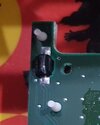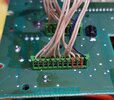Sergeant_Dreizehn
- Jan 16, 2024
- 9
- Joined
- Jan 16, 2024
- Messages
- 9
Hello,
I've been repairing a bunch of dead bulbs and things on my mother's 04' GMC Yukon, in the radio and the instrument cluster. Most of the repair went fine, but there is one 3mm radio bulb socket causing strange issues.
When removed from the circuit board, the bulb works fine. However, once soldered in, the bulb is really dim, even if I apply the current directly to its leads. I've tried two different bulbs and re-soldering (admittedly I'm still learning soldering), but the result is the same. They are brand new 12v incadescent bulbs, by the way.
I think the traces on the board are ok, but I don't know for sure. There's definitely an issue with power getting to the bulb, but my whole experience in PCB repair amounts to swapping out a few parts and resoldering a few pins, so I'm not sure what to do next.
Does anyone have any suggestions on what it could be or what I could try? Or if not, perhaps another place I could ask? Any assistance would be much appreciated.
Thank you.
Because of the size limit on images, here are links to them on my Google Drive:
-Front with bulbs illuminated
-Back of PCB with soldered pins
-Close up of bulb pins
-Radio face for reference
P.S. I have no idea what the clear goop is on all the solder points. If it's flux, it must be petrified, as it's hard as a rock, and I'm afraid of damaging the board if I try to clean it up any more.
I've been repairing a bunch of dead bulbs and things on my mother's 04' GMC Yukon, in the radio and the instrument cluster. Most of the repair went fine, but there is one 3mm radio bulb socket causing strange issues.
When removed from the circuit board, the bulb works fine. However, once soldered in, the bulb is really dim, even if I apply the current directly to its leads. I've tried two different bulbs and re-soldering (admittedly I'm still learning soldering), but the result is the same. They are brand new 12v incadescent bulbs, by the way.
I think the traces on the board are ok, but I don't know for sure. There's definitely an issue with power getting to the bulb, but my whole experience in PCB repair amounts to swapping out a few parts and resoldering a few pins, so I'm not sure what to do next.
Does anyone have any suggestions on what it could be or what I could try? Or if not, perhaps another place I could ask? Any assistance would be much appreciated.
Thank you.
Because of the size limit on images, here are links to them on my Google Drive:
-Front with bulbs illuminated
-Back of PCB with soldered pins
-Close up of bulb pins
-Radio face for reference
P.S. I have no idea what the clear goop is on all the solder points. If it's flux, it must be petrified, as it's hard as a rock, and I'm afraid of damaging the board if I try to clean it up any more.


